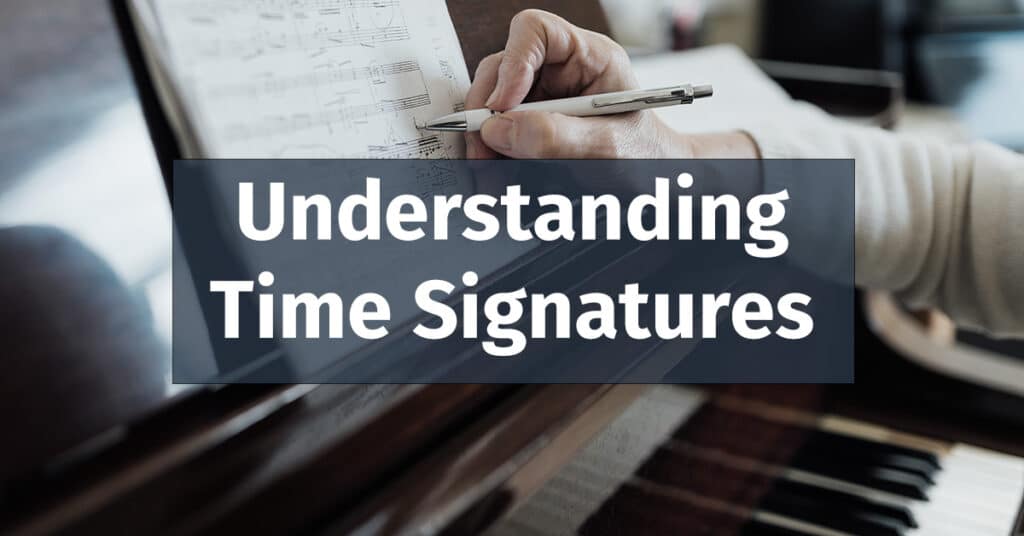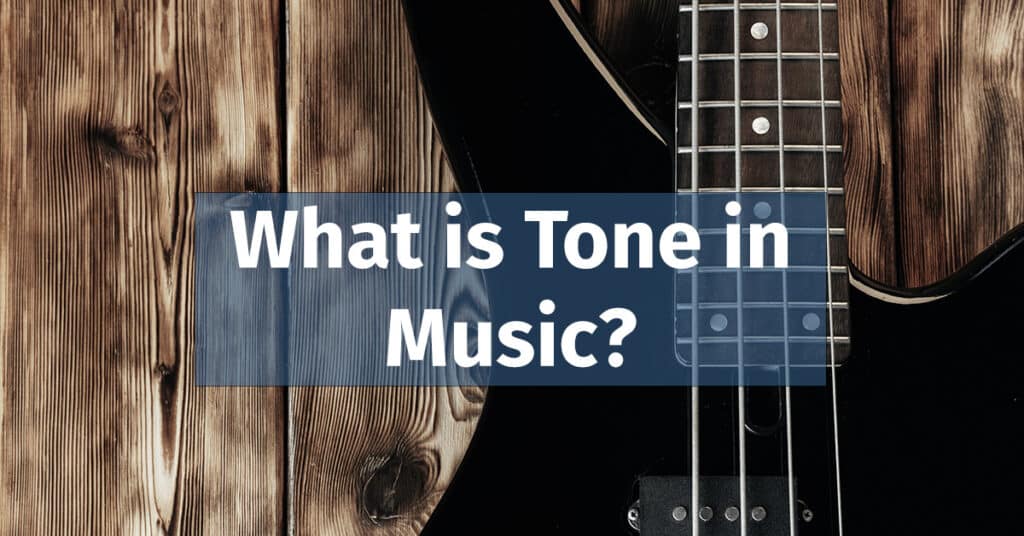Time signatures in music dictate the rhythmic pulse of a composition, indicating how many beats are in each measure and the type of note that gets one beat. They are the rhythmic blueprints that shape a song’s feel and movement.
Introduction
Central to every piece of music you’ve ever loved, the time signature is a crucial component of the rhythm structure, dictating the very pulse of the music.
In its simplest form, a time signature is a musical notation that tells you how many beats are in each measure and what kind of note gets one beat. This, combined with tempo—another crucial aspect of music that sets the speed at which these beats are played—creates the foundation of rhythm.
It’s like a recipe for rhythm, specifying the key ingredients and their quantities. While tempo is vast and critical, we’ll focus on time signatures in this article.
Imagine a time signature as the heartbeat of a song, setting the pace and driving the rhythm. This rhythmic pulse guides musicians and informs how they perform, similar to how a blueprint guides architects.
Time signatures are vital in the composition process as well. They shape the rhythmic framework for composers, allowing them to craft their musical ideas and phrases. Utilizing them effectively can empower you to create music with a specific feel or emotion.
For listeners and dancers, such rhythmic markers indirectly influence how we perceive and physically respond to music. They play a part in why we tap our feet, sway, or dance in a particular way to the beat of a song. In essence, they contribute significantly to the overall musical experience.
In the subsequent sections, we’ll explore time signatures in greater detail. We’ll delve into their components, discuss different types, and see how they apply to various musical contexts.
With this knowledge, you’ll have a more profound understanding of how music flows and pulses, empowering you to create, perform, and enjoy music with enriched insight.
The Basics of Time Signatures
Now that you have an introductory understanding of time signatures, let’s dissect this concept further. These rhythmic notations can be regarded as a musical “fraction” written at the beginning of a musical piece, right after the clef and key signature.
A time signature comprises two numbers, one on top of the other. The top number denotes the number of beats in each measure, while the bottom number specifies the type of note that equals one beat.
To understand it more vividly, let’s think about a measure as a container and beats as units of rhythm. The time signature then tells us how many units can fit into this container and what size each unit is.
For instance, a 4/4 time signature implies that a measure (the container) can hold four beats (units) and that a quarter note (shown by the “4” at the bottom) represents one beat.
On the music staff, measures are represented by vertical lines that segment the staff into separate compartments. Each measure then contains several beats, as shown by the top number of the time signature. These divisions provide a visual representation that helps musicians follow the rhythm of the music more easily.
By compartmentalizing the beats into individual measures, musicians can accurately interpret the rhythm, anticipate the timing of notes and rests, and better coordinate their playing with other musicians in ensemble settings.
For instance, if the time signature is 4/4, each segment or measure on the music staff will contain four beats.
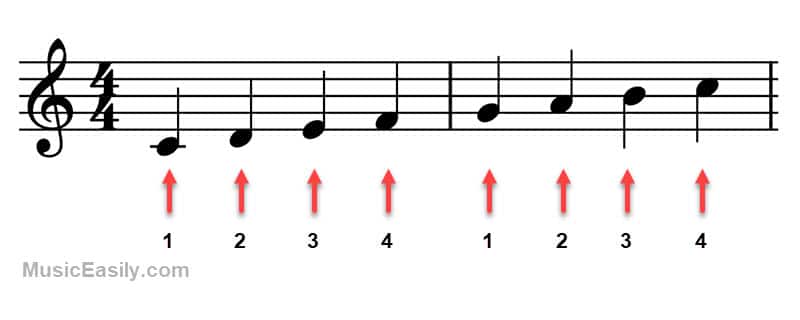
An important concept to grasp is that these “containers,” or measures, must always contain the same total rhythmic duration, no matter how you fill them. Whether you use quarter notes, eighth notes, rests, or a combination, the total value within each measure must align with the time signature.
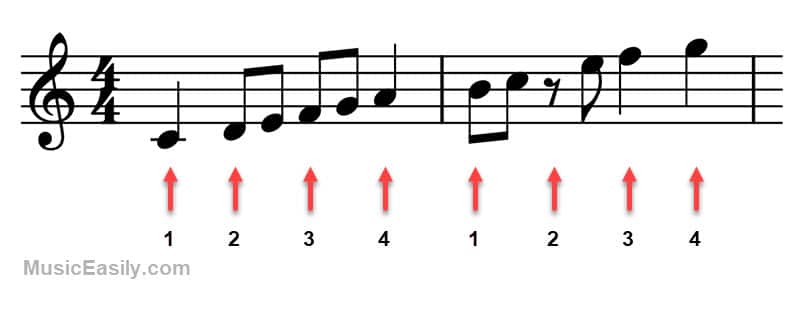
It’s also important to understand the distinction between beats and bars. While “beats” refer to the rhythmic units in a measure, a “bar” (or measure) is a section of time defined by a given number of beats, as determined by the time signature.
What is Meter in Music?
In music, the meter plays a key role in establishing the rhythmic foundation of a composition. It transcends the basic count of beats in each measure, embodying a repeating pattern of accents and thus forming a rhythmic blueprint that structures and shapes the beats.
This organizing principle of beats, indicated by what is commonly referred to as time signatures, is sometimes dubbed “meter signatures” owing to their pivotal role in defining the meter.
Classical musicians often use the term “meter” to describe this rhythmic organization, as in “4/4 meter“. In contrast, musicians in the jazz and pop genres typically lean towards the term “time“, referring to the same rhythmic organization as “4/4 time“.
Regardless of the terminology, the fundamental concept remains the same. Understanding meter in music can begin with reflecting on the rhythmic patterns we often encounter daily.
The rhythm of footsteps when we walk, or the pattern of a bouncing ball, are natural rhythms we tend to perceive in specific patterns due to our innate tendency to emphasize or stress certain beats. This human interpretation of patterns is also central to the concept of musical meter.
To see how this applies to a piece of music, let’s take the 4/4 time signature as an example. The top number indicates there are four beats in each measure. But, if we were to simply listen to these beats without any context, they might seem identical, much like the ticking of a clock.
However, as listeners, we instinctively perceive and anticipate patterns. We might naturally interpret the first beat as strong, the second as lighter, the third as somewhat strong again, and the fourth as the lightest.
This strong-weak-medium-weak pattern, which emerges from our perception and anticipation, guides our experience of the rhythm throughout the piece and forms the musical meter.
Once a meter is established, listeners intuitively adhere to it, even when the composition slightly veers off the rhythmic path. We inherently maintain the metric structure as long as minimal rhythmic cues are present.
While a time signature provides the fundamental beat count, the meter adds depth by deciding how these beats are experienced, emphasized, and grouped. It’s the underlying pulse we naturally synchronize with when listening to music.
Remember, though meter is often indicated by time signatures, it goes beyond mere notation. Grasping the concept of musical meter necessitates perceiving and anticipating a sequence of beats extracted from the unfolding musical composition.
Simple, Compound, Duple, Triple, and Quadruple Meters
Musical meters, which determine the rhythm and feel of a piece, can be broadly classified into simple and compound categories. Additionally, they can be described as duple, triple, or quadruple, which tells us how many primary beats are in each measure.
- Simple meters subdivide each beat into two equal parts. Imagine clapping your hands to the beat of a song – each clap represents a beat. Examples of simple meter include 2/4 (simple duple), 3/4 (simple triple), and 4/4 (simple quadruple). The top number tells you how many beats are in each measure, and the bottom number tells you what type of note gets the beat. In 2/4 time, for example, each measure contains two beats, and each beat is a quarter note.
- Compound meters, on the other hand, divide each primary beat into three equal parts. This can create a swing or lilting feel to the music. Examples of compound meter include 6/8 (compound duple), 9/8 (compound triple), and 12/8 (compound quadruple). In 6/8 time, for example, there are six beats in each measure, but they are grouped in two sets of three. Each primary beat (in this case, a dotted quarter note) is divided into three smaller beats.
The terms “beat” and “primary beat” are used differently in simple and compound meters to differentiate between the pulse we naturally feel in a piece of music (the primary beat) and the subdivision of that beat.
In simple meters, each beat is essentially the same and is divided into two. However, in compound meters, what we often perceive as the “beat” (the primary beat) comprises smaller beats, each dividing into three.
The emphasis pattern in a compound meter like 6/8 is “strong-weak-weak” for each primary beat. So across a whole measure, the emphasis pattern is “ONE-two-three, FOUR-five-six.”
The first beat (“ONE”) is typically the strongest, and the fourth beat (“FOUR”) is less strong but still accented. This gives a rhythmic feel of two main beats, each subdivided into three parts.
We differentiate meters by how many primary beats are in each measure—duple, triple, or quadruple. For example, there are two primary beats per measure in simple duple time, as in 2/4 time. There are three primary beats per measure in simple triple time, like in 3/4 time. And in simple quadruple time, there are four primary beats per measure, as in 4/4 time.
In compound meters, the number of primary beats per measure is determined similarly, but remember, each primary beat is divided into three.
So, in compound duple time, there are two primary beats that divide into three, for a total of six beats in each measure, as in 6/8 time. In compound triple time, there are three primary beats that divide into three, for a total of nine beats in each measure, as in 9/8 time.
Recognizing whether a meter is simple or compound and whether it’s duple, triple, or quadruple is critical for reading and performing music accurately and expressively.
Impact of Meter on Music
Understanding the difference between simple and compound meters isn’t just for seasoned musicians—it’s an essential aspect of rhythm that gives music its unique texture and character.
Simple meters, indicated by time signatures such as 2/4, 3/4, and 4/4, split the beat into two equal parts. This results in a steady and predictable rhythm. This rhythmic structure is often found in rock, pop, and classical music.
On the other hand, compound meters, represented by time signatures like 6/8, 9/8, and 12/8, divide the primary beat into three equal parts.
In a compound meter such as 6/8, the six beats are typically grouped into two sets of three, creating a rhythm reminiscent of a “dotted quarter note” pulse. This imparts a triplet feel to the music, adding a swing or sway effect frequently seen in folk, jazz, and blues genres.
The choice between using a simple or compound meter can significantly alter the character of a piece of music. Understanding these meters is key to appreciating the rhythmic intricacies of music.
Understanding Different Time Signatures
In the previous section, we explored the concept of musical meter and its two broad categories: simple and compound. We also delved into how these meters manifest in different music genres, adding unique texture and character to the rhythm of a piece.
Now, let’s focus on specific time signatures representing these meters. We will examine a selection of commonly used time signatures, both simple and compound.
While these represent a significant proportion of what we see in Western music, they are not the only possible time signatures. Nevertheless, understanding these will equip you with a solid foundation to interpret most musical compositions’ rhythmic structure and feel.
Simple Time Signatures
Simple time signatures divide each measure into two, three, or four beats. These basic rhythmic structures form the foundation of many compositions. In this section, we’ll detail the characteristics and the visualization of these time signatures on a musical staff.
The 2/4 Time Signature
The 2/4 time signature, which comprises two beats per measure with each quarter note representing one beat, manifests an energetic and brisk character in music. A perfect exemplification of this can be found in Nikolai Rimsky-Korsakov’s “Flight of the Bumblebee.”
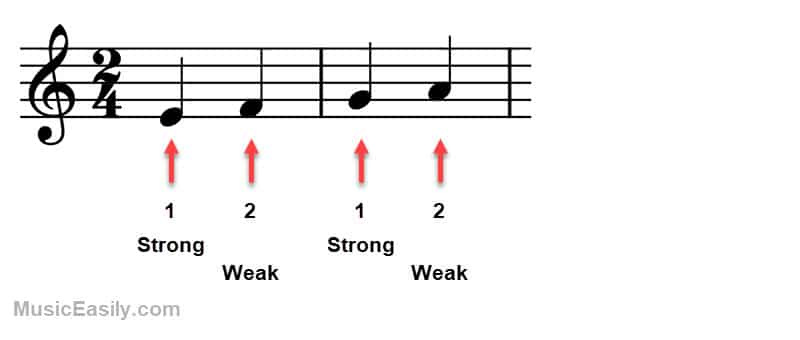
The 3/4 Time Signature and Waltz Time
A waltz wouldn’t be a waltz without the lilting rhythm of the 3/4 time signature. With three beats per measure and the quarter note representing one beat, 3/4 time introduces a graceful, swaying rhythm, like the ebb and flow of the ocean waves.
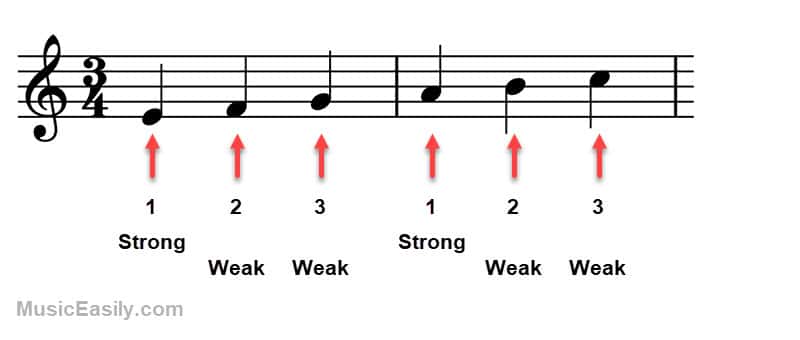
This rhythm is epitomized in Johann Strauss II’s “The Blue Danube,” where the 3/4 time signature creates the distinct flowing rhythm associated with the waltz.
The 4/4 Time Signature (Common Time)
The most prevalent time signature in Western music, 4/4, is often referred to as “common time.” It is so frequently used that it can also be notated as a “C” on the music staff. This “C” stands for “common time,” a shorthand notation that has evolved over centuries of musical practice.
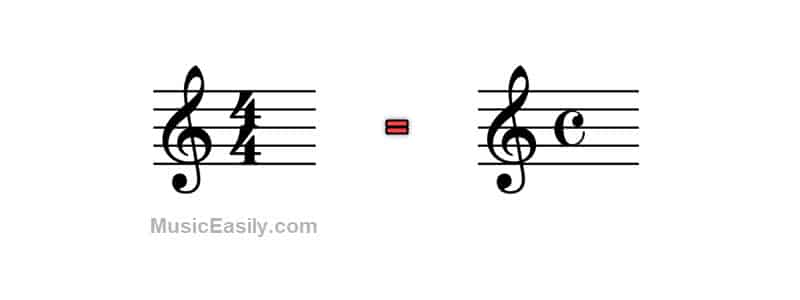
Despite this commonplace designation, 4/4 time holds a wealth of potential for rich and varied musical expression. This time signature denotes four beats in each measure, with the quarter note representing one beat. The rhythmic stability of 4/4 time is vital in various genres spanning pop, rock, classical, and beyond.
The prevalence of 4/4 time can be attributed to its natural, intuitive feel. Our walking pattern, for instance, usually follows an even, four-beat cycle—left, right, left, right. This rhythm is so ingrained in us that it makes 4/4 meter feel intuitive and “common.”
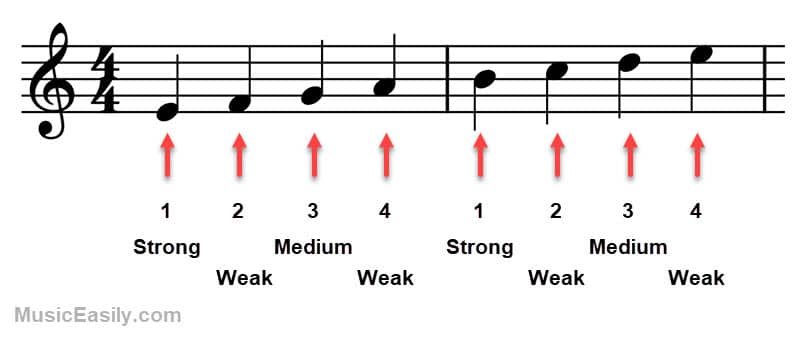
To understand 4/4 time better, consider well-known songs that employ this time signature. A classic holiday song like “Jingle Bells” provides a straightforward example of 4/4 time.
Similarly, the globally recognized rock anthem “We Will Rock You” by Queen is another song written in the 4/4 meter. Both these songs can serve as effective aural references when trying to understand the 4/4 time signature.
The 2/2 Time Signature (Cut Time)
The “2/2” time signature, also known as “cut time” or “alla breve,” is a crucial type of simple time signature that is worth understanding in depth. It can be represented by the numerical 2/2 or sometimes symbolized with a “C” with a vertical line through it.
There are two beats per measure in cut time, with the half note getting the beat. This time signature often appears in faster music genres like marches, giving the rhythm a brisk, propelling quality. The rhythm follows a “strong-weak” beat pattern, like in 2/4 time.
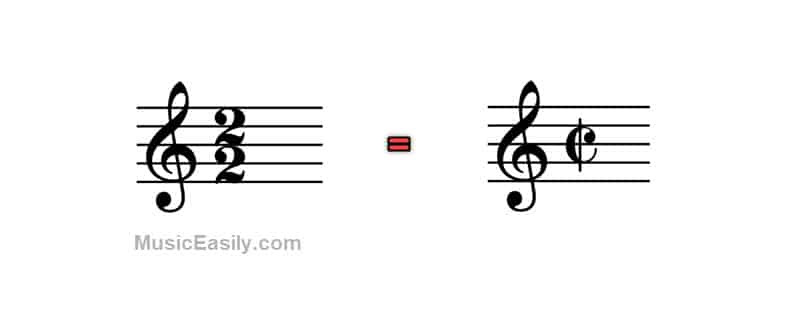
The term “cut time” originates from its function—it effectively “cuts” the rhythmic note values in half compared to 4/4 time. This modification doesn’t increase the tempo (BPM), but it does change the notation, which can create a feeling of a faster pace or more urgency to the rhythm.
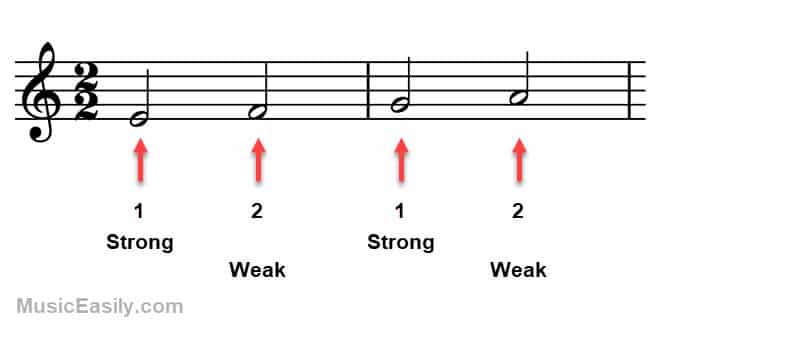
Consider an example where a piece of music transitions from a 4/4 time signature to a 2/2 time signature while the tempo remains unchanged. Each beat in the 2/2 measure lasts twice as long as in the 4/4 measure, and because more notes or musical events can happen within each beat, the music may feel like it’s moving faster.
The fascinating transformation can be understood more clearly by realizing that quarter notes in 4/4 time become akin to eighth notes in cut time. The image below visually explains this shift in perception, showing a 2/2 staff with a combination of half and quarter notes.
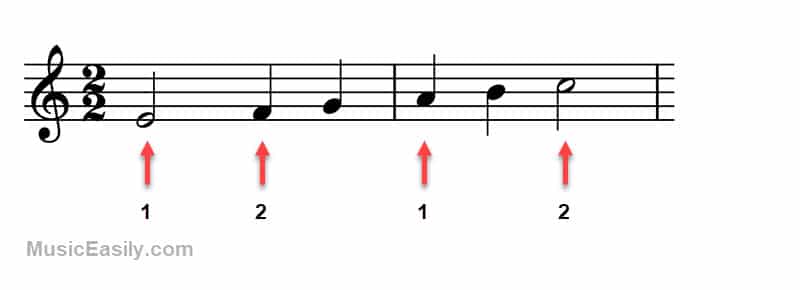
In summary, cut time allows composers and musicians to manipulate the feel of rhythm, even while keeping the same tempo. This underlines the sheer depth and breadth of possibilities within musical composition.
Compound Time Signatures
Compound time signatures, in contrast, divide each beat into three parts, imbuing the rhythm with an added complexity and a unique swing. This section explains how these time signatures are structured and represented on a musical staff.
The 6/8 Time Signature
In the case of the 6/8 time signature, we experience two primary beats per measure, each divided into three eighth notes, providing the music with a flowing, lilting rhythm.
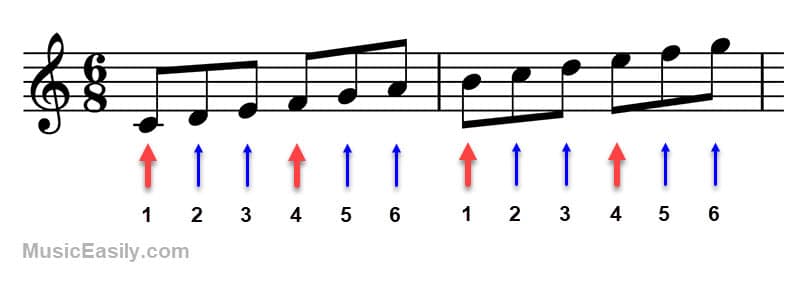
This signature manifests beautifully in compositions such as “House of the Rising Sun” by The Animals.
The 9/8 Time Signature
The 9/8 and 12/8 further build upon the compound meter concept, offering more complex rhythmic structures. The 9/8 time signature, with three primary beats in a measure and each beat divided into three eighth notes, is a favorite among folk and traditional music. “The Rocky Road to Dublin,” a popular Irish folk song, is a classic example of 9/8 time.
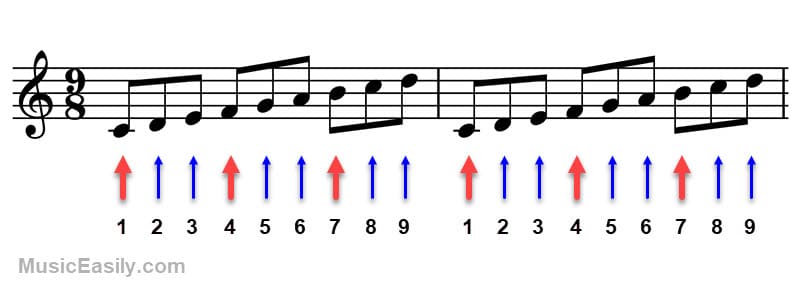
The 12/8 Time Signature
Meanwhile, the 12/8 time signature, which consists of four primary beats in a measure, each subdivided into three eighth notes, gives music a characteristic swing feel. This time signature is commonly employed in various genres and can be heard in songs such as Alicia Keys’ “Fallin’.”
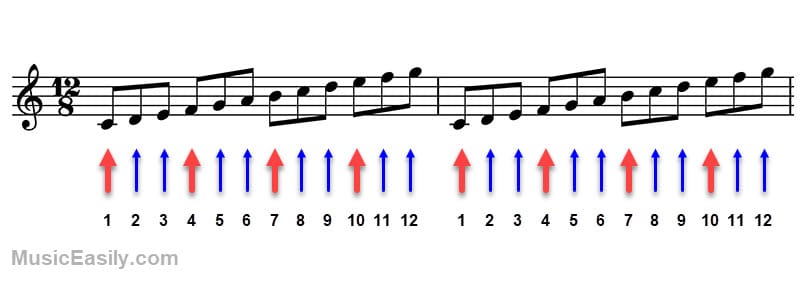
Identifying Time Signatures in Songs
Identifying the time signature of a song can greatly enhance your understanding of its structure and your overall listening experience.
This skill is useful for musicians aiming to play or cover the piece and provides insightful knowledge for composers, arrangers, and avid music enthusiasts. So, how do you identify the time signature of a song by ear? Let’s get into it.
Finding the Pulse
Before you can identify a song’s time signature, you first need to locate the “pulse” or the beat of the music.
This is the steady rhythm that you might tap your foot or nod your head as you listen. It’s the rhythmic backbone that supports the entire structure of a piece.
Listen to a song, close your eyes, and try to tap along with the music. This pulse is the basic unit we count when determining a time signature.
Counting the Beats
Once you’ve identified the pulse, the next step is to count how many of these beats fit into a “measure” or “bar.” These terms refer to a segment of time corresponding to a specific number of beats.
The most common time signature is 4/4, so start by counting to four along with the pulse. If it fits naturally, you’re likely dealing with a 4/4 time signature. If not, try counting in threes for a 3/4 time or twos for a 2/4 time.
Listen for Emphasis
Often, the first beat of a measure is emphasized or “accented.” This can be a louder drum hit, a chord change, or a noticeable musical event. Try to identify these points of emphasis; they often signal the beginning of a new measure.
Considering the Genre
The genre of the song can often provide clues as to its likely time signature. For example, waltzes are always in 3/4 time, while a lot of rock and pop music is written in 4/4.
Folk or world music can sometimes feature more complex or unusual time signatures. While the genre isn’t a definitive guide, it can provide a helpful context.
Practice
Like any skill, the ability to identify time signatures improves with practice. Start with familiar songs, then gradually work your way up to unknown or more complex tracks.
Over time, you’ll become more adept at discerning the underlying rhythmic framework of a song. Understanding and identifying time signatures by ear is a powerful skill that deepens your relationship with music.
Whether you’re a beginner or an experienced musician, enhancing your rhythmic understanding can add new dimensions to your musical experience, composition, and appreciation.
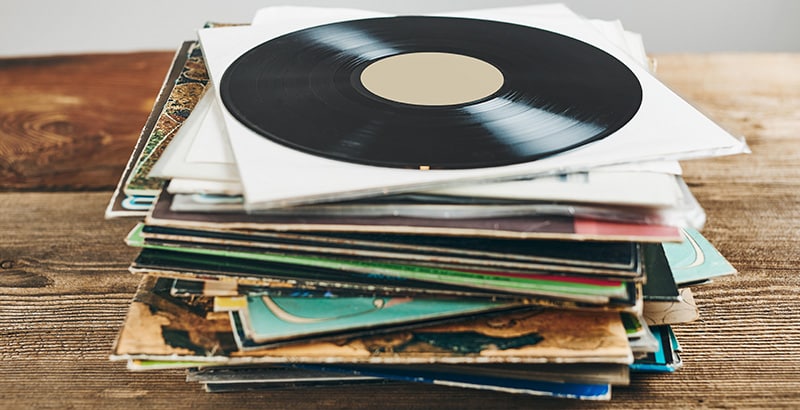
Remember, patience is key; not everyone will master this overnight. However, with perseverance and much practice, you’ll find your rhythm, one beat at a time.
Time Signatures and Rhythm: The Connection
One of the vital aspects of music is rhythm, a component often dictated by the time signature. The time signature establishes the rhythmic grid on which notes are placed, and hence, it significantly influences a song’s rhythm and overall feel.
The Rhythmic Role of Time Signatures
At its most fundamental level, a time signature dictates how many beats are in each measure and which note value gets the beat. By setting these parameters, the time signature provides the rhythmic foundation for the piece.
For example, in a 4/4 time signature, the rhythm will be typically organized around groups of four quarter-note beats, while in 3/4 time, the rhythm will be grouped in threes.
Time Signatures and Rhythmic Feel
Different time signatures can create distinct rhythmic feelings. A piece in 4/4 time, often called “common time,” provides a strong and steady rhythm widely used in pop, rock, and classical music.
In contrast, a 3/4 time signature, commonly associated with waltzes, offers a cyclical, swaying rhythm. This “ONE-two-three, ONE-two-three” feel is less symmetrical than 4/4 time and can provide a sense of movement or flow.
On the other hand, time signatures like 6/8 create a compound rhythmic feel, where the beat can be subdivided into smaller parts. This results in a “dotted” rhythm, often associated with genres like jazz, blues, or folk music.
Unusual Time Signatures and Rhythm
Finally, time signatures can significantly impact the emotional resonance of a song. A steady 4/4 beat might communicate confidence or drive, while an unusual time signature could convey tension, unrest, or intrigue.
Therefore, as a songwriter or composer, it’s crucial to consider how your choice of time signature will impact the rhythm and feel of your piece. Whether aiming for a straightforward dance beat or a complex rhythmic pattern, the time signature is one of your key tools.
While time signatures provide the structural backbone of a song, their impact on the rhythm brings the music to life. Understanding how various forms of these notations affect rhythm is a valuable tool for any musician, songwriter, or music enthusiast.
The power to shape the rhythmic feel of a song lies within your understanding and deliberate use of time signatures.
Modifying Rhythm: Half Time and Double Time
As you delve deeper into music and rhythm, you’ll come across terms like “half time” and “double time.” These terms don’t change the time signature itself, but they significantly alter the feel of the music within a given time signature.
In “half time,” the feel of the tempo is halved, creating a slowed-down effect.
This doesn’t mean that the actual tempo or beat of the music has changed, but rather the rhythmic emphasis makes it feel slower. Imagine marching to a beat, then slowing your march to step on every other beat while the actual pace of the beats remains the same. That’s the effect of half time.
On the other hand, “double time” gives the impression of the tempo being doubled.
Again, the underlying beat remains steady, but the rhythm is played so that it feels much faster. Using the marching analogy, you would take two steps for each beat instead of one, creating a quicker feel.
These techniques are used extensively across various musical genres to introduce contrast, build tension, or vary the rhythmic landscape of a piece. Listening to these changes can enhance your musical understanding and enjoyment.
Conclusion
Now that you’re familiar with these rhythmic notations and their implications, it’s time to put theory into practice. Incorporate different rhythmic frameworks in your compositions.
Remember, there’s no “one-size-fits-all” when choosing a time signature. The choice will always depend on the mood, style, and rhythmic feel you want to achieve. Diversifying the rhythmic structures can breathe new life into your music.
For example, transitioning from a common 4/4 signature to a less common 7/8 can drastically shift the mood and introduce a unique rhythmic texture. Such a change can make your composition stand out, particularly in genres where unusual rhythmic frameworks aren’t common.
Moreover, experimenting with diverse time signatures can also challenge your compositional skills. Navigating the musical landscape with a new rhythmic blueprint can spur creativity. This approach offers intriguing rhythm patterns, syncopations, and groove possibilities that remain unexplored in more common frameworks.
If you want to delve into more complex musical landscapes, you can learn about additive rhythm, odd meters, and more on the Wikipedia page about Complex Time Signatures (ext. link). This knowledge can further enhance your compositional toolbox and understanding of rhythm.
In essence, exploring time signatures is a journey of musical discovery. As you delve into the world of different beats and rhythms, you’ll find yourself creating music that is uniquely your own. So shake things up a bit and see where this rhythmic adventure takes your music.
Remember, the most captivating compositions often break boundaries and challenge norms. Hence, don’t hesitate to step outside the familiar territory of standard rhythmic notations and uncover the thrilling rhythmic possibilities across the broad spectrum of musical time.
